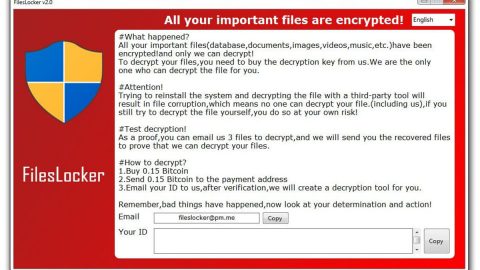What is .excuses File Extension ransomware? And how does it carry out its attack?
.excuses File Extension ransomware is a file-encrypting threat set to encrypt files in an infected system. This ransomware threat was first discovered on April 2, 2018. At the time of writing, there is only a handful of information about this threat but according to security experts, it may be created based on the open source platform, HiddenTear and that it targets the following file extensions once it infiltrates a system.
.3gp, .7z, .apk, .avi, .bmp, .cdr, .cer, .chm, .conf, .css, .csv, .dat, .db, .dbf, .djvu, .dbx, .docm, doc, .epub, .docx .fb2, .flv, .gif, .gz, .iso .ibooks,.jpeg, .jpg, .key, .mdb .md2, .mdf, .mht, .mobi .mhtm, .mkv, .mov, .mp3, .mp4, .mpg .mpeg, .pict, .pdf, .pps, .pkg, .png, .ppt .pptx, .ppsx, .psd, .rar, .rtf, .scr, .swf, .sav, .tiff, .tif, .tbl, .torrent, .txt, .vsd, .wmv, .xls, .xlsx, .xps, .xml, .ckp, .zip, .java, .py, .asm, .c, .cpp, .cs, .js, .php, .dacpac, .rbw, .rb, .mrg, .dcx, .db3, .sql, .sqlite3, .sqlite, .sqlitedb, .psd, .psp, .pdb, .dxf, .dwg, .drw, .casb, .ccp, .cal, .cmx, .cr2
Once it finds the files it’s been looking for, .excuses File Extension ransomware will encrypt them using a strong encryption algorithm and append the “.excuses” extension to each one of the encrypted files. Following data encryption, this crypto-malware drops a file named “MESSAGE.txt” containing the following text written in Russian:
“Приобрести декриптор можно до 02.04.2018
Запросить стоимость: [email protected]
В ТЕМЕ письма укажите ваш ID: [redacted numbers]
Письма без указания ID игнорируются.
Убедительная просьба не пытаться расшифровать файлы сторонними инструментами.
Вы можете их окончательно испортить и даже оригинальный декриптор не поможет.
Заявки обрабатываются автоматической системой”
Here’s the ransom note translated from Russian to English:
“You can buy the decryptor before 04/02/2018
Request cost: [email protected]
In the subject of the letter, indicate your ID: [redacted numbers]
Letters without an ID are ignored.
Please do not try to decrypt files with third-party tools.
You can ruin them entirely and even the original decryptor will not help.
Applications are processed by an automated system.”
According to researchers, .excuses File Extension ransomware might target Russian speaking users as its ransom note suggests. But that does not necessarily mean that it can’t affect other users from other parts of the globe as well.
How does .excuses File Extension ransomware spread its malicious file(s)?
To infect computers, .excuses File Extension ransomware uses malicious spam email campaigns in spreading its malicious files. These files are usually documents with macro scripts used to execute a command in the system once it is opened. As a result, .excuses File Extension ransomware will be downloaded from its remote server and installed in the system. This is the reason why you need to be cautious in opening any kind of email attachment no matter who sent them as crooks tend to use spam bots and disguise them to make them look like they’re from legitimate and well-known companies or group.
For the removal of .excuses File Extension ransomware, follow the given steps below.
Step 1: Tap Ctrl + Shift + Esc keys to launch the Task Manager.
Step 2: Go to Processes and look for the malicious process of .excuses File Extension ransomware then right click on it and select End Process or End Task.

Step 3: Close the Task Manager and open Control Panel by pressing the Windows key + R, then type in appwiz.cpl and then click OK or press Enter.
Step 4: Look for dubious programs that might be related to .excuses File Extension ransomware and then Uninstall it/them.
Step 5: Tap Win + E to launch File Explorer.
Step 6: From there, navigate to the following directories listed below and look for the malicious components of .excuses File Extension ransomware like MESSAGE.txt and remove them all.
- %TEMP%
- %APPDATA%
- %DESKTOP%
- %USERPROFILE%\Downloads
- C:\ProgramData\local\
Step 7: Close the File Explorer.
Before you proceed to the next steps below, make sure that you are tech savvy enough to the point where you know exactly how to use and navigate your computer’s Registry. Keep in mind that any changes you make will highly impact your computer. To save you the trouble and time, you can just use [product-name], this system tool is proven to be safe and excellent enough that hackers won’t be able to hack into it. But if you can manage Windows Registry well, then, by all means, go on to the next steps.
Step 8: Tap Win + R to open Run and then type in regedit in the field and tap enter to pull up Windows Registry.

Step 9: Navigate to the listed paths below and look for the registry keys and sub-keys created by .excuses File Extension ransomware.
- HKEY_CURRENT_USER\Control Panel\Desktop\
- HKEY_USERS\.DEFAULT\Control Panel\Desktop\
- HKEY_LOCAL_MACHINE\Software\Microsoft\Windows\CurrentVersion\Run
- HKEY_CURRENT_USER\Software\Microsoft\Windows\CurrentVersion\Run
- HKEY_LOCAL_MACHINE\Software\Microsoft\Windows\CurrentVersion\RunOnce
- HKEY_CURRENT_USER\Software\Microsoft\Windows\CurrentVersion\RunOnce
Step 10: Delete the registry keys and sub-keys created by .excuses File Extension ransomware.
Step 11: Close the Registry Editor.
Step 12: Empty your Recycle Bin.
Try to recover your encrypted files using the Shadow Volume copies
Restoring your encrypted files using Windows’ Previous Versions feature will only be effective if .excuses File Extension ransomware hasn’t deleted the shadow copies of your files. But still, this is one of the best and free methods there is, so it’s definitely worth a shot.
To restore the encrypted file, right-click on it and select Properties, a new window will pop-up, then proceed to Previous Versions. It will load the file’s previous version before it was modified. After it loads, select any of the previous versions displayed on the list like the one in the illustration below. And then click the Restore button.

Complete the removal process of .excuses ransomware by using a trusted and reliable program like [product-name]. Refer to the following guidelines on how to use it.
Perform a full system scan using [product-code]. To do so, follow these steps:
- Turn on your computer. If it’s already on, you have to reboot
- After that, the BIOS screen will be displayed, but if Windows pops up instead, reboot your computer and try again. Once you’re on the BIOS screen, repeat pressing F8, by doing so the Advanced Option shows up.
- To navigate the Advanced Option use the arrow keys and select Safe Mode with Networking then hit
- Windows will now load the SafeMode with Networking.
- Press and hold both R key and Windows key.
- If done correctly, the Windows Run Box will show up.
- Type in the URL address, [product-url] in the Run dialog box and then tap Enter or click OK.
- After that, it will download the program. Wait for the download to finish and then open the launcher to install the program.
- Once the installation process is completed, run [product-code] to perform a full system scan.
















